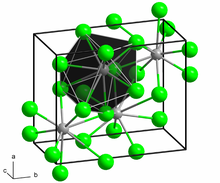Europium(II) chloride is an inorganic compound with a chemical formula EuCl2. When it is irradiated by ultraviolet light, it has bright blue fluorescence.[3]

| |

| |
| Names | |
|---|---|
| Other names
Europium dichloride
| |
| Identifiers | |
| |
3D model (JSmol)
|
|
| ChemSpider | |
| ECHA InfoCard | 100.033.973 |
| EC Number |
|
PubChem CID
|
|
CompTox Dashboard (EPA)
|
|
| |
| |
| Properties | |
| Cl2Eu | |
| Molar mass | 222.86 g·mol−1 |
| Appearance | white solid |
| Density | 4.86 g·cm−3[1] |
| Melting point | 738 °C (1,011 K)[2] |
| Boiling point | 2,190 °C (2,460 K)[2] |
| Related compounds | |
Other anions
|
europium difluoride europium dibromide europium diiodide |
Other cations
|
samarium dichloride thulium dichloride |
Related compounds
|
europium trichloride |
Except where otherwise noted, data are given for materials in their standard state (at 25 °C [77 °F], 100 kPa).
| |
Preparation
editEuropium dichloride can be produced by reducing europium trichloride with hydrogen gas at high temperature:[4]
- 2 EuCl3 + H2 → 2 EuCl2 + 2 HCl
If dry europium trichloride reacts with lithium borohydride in THF, it can also produce europium dichloride:[5]
- 2 EuCl3 + 2 LiBH4 → 2 EuCl2 + 2 LiCl + H2↑ + B2H6↑
Properties
editEuropium dichloride can form yellow ammonia complexes:EuCl2•8NH3, and can dissolve to pale yellowish EuCl2•NH3.[4] Europium dichloride can react with europium hydride at 120-bar H2, producing EuClH that fluoresces green.[6]
References
edit- ^ Roger Blachnik (Hrsg.): Taschenbuch für Chemiker und Physiker. Band III: Elemente, anorganische Verbindungen und Materialien, Minerale. begründet von Jean d’Ans, Ellen Lax. 4., neubearbeitete und revidierte Auflage. Springer, Berlin 1998, ISBN 3-540-60035-3, S. 446–447
- ^ a b Polyachenok, O. G.; Novikov, G. I. Saturated vapor pressures of SmCl2, EuCl2, YbCl2. Zhurnal Neorganicheskoi Khimii, 1963. 8 (12): 2631–2634. ISSN 0044-457X.
- ^ Howell, J.K.; Pytlewski, L.L. (August 1969). "Synthesis of divalent europium and ytterbium halides in liquid ammonia". Journal of the Less Common Metals. 18 (4): 437–439. doi:10.1016/0022-5088(69)90017-4.
- ^ a b Klemm, Wilhelm; Doll, Walter. Measurements on the bivalent and the quadrivalent compounds of the rare earths. VI. The halides of bivalent europium. Zeitschrift für Anorganische und Allgemeine Chemie, 1939. 241: 233–238. ISSN 0044-2313.
- ^ Rossmanith, K.; Muckenhuber, E. Reaction of rare earth chlorides with lithium borohydride. II. Monatshefte fuer Chemie, 1961. 92: 600–604. ISSN 0026-9247.
- ^ Kunkel, Nathalie; Rudolph, Daniel; Meijerink, Andries; Rommel, Stefan; Weihrich, Richard; Kohlmann, Holger; Schleid, Thomas (2015). "Green Luminescence of Divalent Europium in the Hydride Chloride EuHCl". Zeitschrift für anorganische und allgemeine Chemie. 641 (7): 1220–1224. doi:10.1002/zaac.201400531. ISSN 0044-2313.